Smart Grid Strategies for Tackling the Duck Curve: A Qualitative Assessment of Digitalization, Battery Energy Storage, and Managed Rebound Effects Benefits
Abstract
1. Introduction
2. Digital Technologies in Smart Energy Management
2.1. Role of Digital Transformation in Modern Energy Systems
2.2. Digital Technologies in Network Management: AI, Edge Computing, IoT and Smart Meters
2.3. Advanced Analytics for Load Forecasting and Grid Control
2.4. Challenges and Opportunities in Digital Energy Management
3. Battery Energy Storage Systems (BESSs) for Duck Curve Mitigation
3.1. Fundamentals and Principles of Battery Energy Storage Systems
3.2. BESS Operational Strategies in Smoothing the Duck Curve
3.3. Integration of BESSs with Renewable Energy Sources and Grid Stability
3.4. Enabling Battery Digital Twins for Intelligent Decision-Making
3.5. Economic, Environmental, and Regulatory Considerations for BESS Deployment
3.6. Advances in Battery Technologies and Their Impact on Grid Flexibility
4. Rebound Effects: Understanding and Mitigation Strategies
4.1. Rebound Effects in the Energy Context
4.2. Impact of Rebound Effects on Electricity Grid Operations
4.3. Digital Tools for Monitoring and Quantifying Rebound Effects
4.4. Policy and Behavioral Strategies to Mitigate Rebound Effects
4.5. Advantages and Disadvantages of Predictive Analytics and Regulatory Strategies Under Comprehensive Digitalization and Intelligence
5. Integrated Approaches for Smart Duck Curve Management
5.1. Synergistic Integration of Digitalization, BESSs, and Managed Rebound Dynamics
5.2. Current State-of-the-Art Implementations and Case Studies
5.3. Demand Response and Adaptive Control Systems
5.4. Comparative Analysis of Integrated Strategies
6. Discussions and Policy Implications
6.1. Emerging Trends in Utility-Focused Smart Grid Technologies
6.2. Research Gaps in Flattening the Duck Curve and Emerging Opportunities
6.3. Policy Frameworks and Regulatory Considerations
6.4. Stakeholder Engagement and Public Acceptance in Energy Transition
7. Conclusions and Recommendations
- (1)
- Technological contributions:
- Deployment of AI-driven predictive models to improve peak load forecasting accuracy.
- Use of edge computing to reduce latency by processing data locally from sensors.
- Integration of AMI, DMS, and ADMS to enable near-real-time data capture for responsive grid operations.
- Adoption of advanced digital platforms that merge real-time analytics with AI to support adaptive control strategies.
- Strategic enhancement of BESS deployment to perform peak shaving and energy arbitrage.
- Implementation of dynamic DRMS to incentivize load shifting during peak demand periods.
- Overall facilitation of a more resilient and adaptive grid, capable of addressing operational challenges such as high renewable integration and the duck curve.
- (2)
- Policy contributions
- Recommendation for a strategic overhaul of current outdated utility practices, emphasizing investment in digital platforms and operational innovation.
- Encourage utilities to adopt a dual approach that combines technological deployment with dynamic demand-side measures.
- Advocate for continuous innovation and adaptive policy measures to match the pace of technological advancement in grid management.
- Promote regulatory engagement and knowledge sharing to accelerate adoption of next-generation grid solutions and enhance policy alignment with emerging technologies.
Funding
Data Availability Statement
Conflicts of Interest
Abbreviations
| ADMS | Advanced Distribution Management System |
| AEMO | Australian Energy Market Operator |
| AI/ML | Artificial Intelligence and Machine Learning |
| ARIMA | Autoregressive Integrated Moving Average |
| BESSs | Battery Energy Storage Systems |
| CAISO | California Independent System Operator |
| DER | Distributed Energy Resources |
| DERMS | Distributed Energy Resources Management System |
| DRMS | Demand Response Management System |
| EMS | Energy Management System |
| ESPI | Energy Savings and Performance Incentive |
| ISOs | Independent System Operators |
| LSTM | Long Short-Term Memory |
| MCS | Microgrid Control System |
| OEMs | Original Equipment Manufacturers |
| PV | Solar Photovoltaic |
| REV | New York’s Reforming the Energy Vision |
| RTOs | Regional Transmission Organizations |
| SCADA | Supervisory Control and Data Acquisition |
| SDEM | Spatial Durbin Error Model |
| SDTSs | System of Digital Twin Systems |
| SOC | State-of-charge |
| SOH | State-of-health |
| STLF | Short-Term Load Forecasting |
| VSTLF | Very Short-Term Load Forecasting |
References
- Nyangon, J.; Byrne, J. Estimating the impacts of natural gas power generation growth on solar electricity development: PJM’s evolving resource mix and ramping capability. WIREs Energy Environ. 2023, 12, e454. [Google Scholar] [CrossRef]
- Byrne, J.; Taminiau, J.; Nyangon, J. American policy conflict in the hothouse: Exploring the politics of climate inaction and polycentric rebellion. Energy Res. Soc. Sci. 2022, 89, 102551. [Google Scholar] [CrossRef]
- Minh, N.Q.; Linh, N.D.; Khiem, N.T.; Quynh, T.H.; Nghia, P.T.; Quan, B.M. Optimization models to flatten duck curve in power grid with high penetration of solar energy. J. Mil. Sci. Technol. 2023, 91, 45–53. [Google Scholar] [CrossRef]
- Calero, I.; Cañizares, C.A.; Bhattacharya, K.; Baldick, R. Duck-Curve Mitigation in Power Grids with High Penetration of PV Generation. IEEE Trans. Smart Grid. 2022, 13, 314–329. [Google Scholar] [CrossRef]
- Pitra, G.M.; Musti, K.S.S. Duck Curve with Renewable Energies and Storage Technologies. In Proceedings of the 2021 13th International Conference on Computational Intelligence and Communication Networks (CICN), Lima, Peru, 22–23 September 2021; pp. 66–71. [Google Scholar]
- Kwon, O.; Lee, S.; Park, J. A numerical study to compensate duck curve of ESS integrated gas turbine system with reused-battery. J. Energy Storage 2022, 55, 105422. [Google Scholar] [CrossRef]
- Debnath, K.B.; Jenkins, D.P.; Patidar, S.; Peacock, A.D. Remote work might unlock solar PV’s potential of cracking the ‘Duck Curve’. Appl. Energy 2024, 367, 123378. [Google Scholar] [CrossRef]
- Singh, R.; Akram, S.V.; Gehlot, A.; Buddhi, D.; Priyadarshi, N.; Twala, B. Energy System 4.0: Digitalization of the Energy Sector with Inclination towards Sustainability. Sensors 2022, 22, 6619. [Google Scholar] [CrossRef]
- Fox-Penner, P. Power After Carbon: Building a Clean, Resilient Grid; Harvard University Press: Cambridge, MA, USA, 2020. [Google Scholar]
- Chreim, B.; Esseghir, M.; Merghem-Boulahia, L. Recent sizing, placement, and management techniques for individual and shared battery energy storage systems in residential areas: A review. Energy Rep. 2024, 11, 250–260. [Google Scholar] [CrossRef]
- Deguenon, L.; Yamegueu, D.; Moussa Kadri, S.; Gomna, A. Overcoming the challenges of integrating variable renewable energy to the grid: A comprehensive review of electrochemical battery storage systems. J. Power Sources 2023, 580, 233343. [Google Scholar] [CrossRef]
- Kong, L.; Mu, X.; Hu, G.; Tu, C. Will energy efficiency improvements reduce energy consumption? Perspective of rebound effect and evidence from Beijing. Energy 2023, 263, 125665. [Google Scholar] [CrossRef]
- Nyangon, J.; Byrne, J. Spatial Energy Efficiency Patterns in New York and Implications for Energy Demand and the Rebound Effect. Energy Sources Part B Econ. Plan. Policy 2021, 16, 135–161. [Google Scholar] [CrossRef]
- Watari, D.; Taniguchi, I.; Onoye, T. Duck Curve Aware Dynamic Pricing and Battery Scheduling Strategy Using Reinforcement Learning. IEEE Trans. Smart Grid. 2024, 15, 457–471. [Google Scholar] [CrossRef]
- Özsoy, T. The “energy rebound effect” within the framework of environmental sustainability. WIREs Energy Environ. 2024, 13, e517. [Google Scholar] [CrossRef]
- Lange, S.; Frick, V.; Gossen, M.; Pohl, J.; Rohde, F.; Santarius, T. The induction effect: Why the rebound effect is only half the story of technology’s failure to achieve sustainability. Front. Sustain. 2023, 4, 1178089. [Google Scholar] [CrossRef]
- Nyangon, J.; Akintunde, R. Principal component analysis of day-ahead electricity price forecasting in CAISO and its implications for highly integrated renewable energy markets. WIREs Energy Environ. 2024, 13, e504. [Google Scholar] [CrossRef]
- Nyangon, J. Climate-proofing critical energy infrastructure: Smart grids, Artificial Intelligence, and machine learning for power system resilience against extreme weather events. J. Infrastruct. Syst. 2024, 30, 03124001. [Google Scholar] [CrossRef]
- Abir, S.M.A.A.; Anwar, A.; Choi, J.; Kayes, A.S.M. IoT-Enabled Smart Energy Grid: Applications and Challenges. IEEE Access 2021, 9, 50961–50981. [Google Scholar] [CrossRef]
- Irmak, E.; Kabalci, E.; Kabalci, Y. Digital Transformation of Microgrids: A Review of Design, Operation, Optimization, and Cybersecurity. Energies 2023, 16, 4590. [Google Scholar] [CrossRef]
- Kabeyi, M.J.B.; Olanrewaju, O.A. Smart grid technologies and application in the sustainable energy transition: A review. Int. J. Sustain. Energy 2023, 42, 685–758. [Google Scholar] [CrossRef]
- Mai, T.T.; Nguyen, P.H.; Tran, Q.-T.; Cagnano, A.; De Carne, G.; Amirat, Y.; Le, A.-T.; De Tuglie, E. An overview of grid-edge control with the digital transformation. Electr. Eng. 2021, 103, 1989–2007. [Google Scholar] [CrossRef]
- Bañales, S. The enabling impact of digital technologies on distributed energy resources integration. J. Renew. Sustain. Energy 2020, 12, 045301. [Google Scholar] [CrossRef]
- Kippke, M.A.; Arboleya, P.; Sayed, I.E. Advanced Metering Infrastructure for Smart Grid Real-Time Energy Management Using Mesh Networks Based in IEEE802.15.4 and 6LoWPAN. In Proceedings of the 2021 IEEE Madrid PowerTech, Madrid, Spain, 28 June–2 July 2021; pp. 1–6. [Google Scholar]
- Goudarzi, A.; Ghayoor, F.; Waseem, M.; Fahad, S.; Traore, I. A Survey on IoT-Enabled Smart Grids: Emerging, Applications, Challenges, and Outlook. Energies 2022, 15, 6984. [Google Scholar] [CrossRef]
- Alsuwian, T.; Shahid Butt, A.; Amin, A.A. Smart Grid Cyber Security Enhancement: Challenges and Solutions—A Review. Sustainability 2022, 14, 14226. [Google Scholar] [CrossRef]
- Saleem, M.U.; Usman, M.R.; Yaqub, M.A.; Liotta, A.; Asim, A. Smarter Grid in the 5G Era: Integrating the Internet of Things with a Cyber-Physical System. IEEE Access 2024, 12, 34002–34018. [Google Scholar] [CrossRef]
- Habbak, H.; Mahmoud, M.; Metwally, K.; Fouda, M.M.; Ibrahem, M.I. Load Forecasting Techniques and Their Applications in Smart Grids. Energies 2023, 16, 1480. [Google Scholar] [CrossRef]
- Ibrahim, B.; Rabelo, L.; Gutierrez-Franco, E.; Clavijo-Buritica, N. Machine Learning for Short-Term Load Forecasting in Smart Grids. Energies 2022, 15, 8079. [Google Scholar] [CrossRef]
- Azemena, H.J.; Ayadi, A.; Samet, A. Explainable Artificial Intelligent as a solution approach to the Duck Curve problem. Procedia Comput. Sci. 2022, 207, 2747–2756. [Google Scholar] [CrossRef]
- Mohseni-Gharyehsafa, B.; Bampoulas, A.; Finn, D.; Pallonetto, F. Energy flexibility and management software in building clusters: A comprehensive review. Energy 2025, 8, 100250. [Google Scholar] [CrossRef]
- Panicucci, S.; Nikolakis, N.; Cerquitelli, T.; Ventura, F.; Proto, S.; Macii, E.; Makris, S.; Bowden, D.; Becker, P.; O’Mahony, N.; et al. A Cloud-to-Edge Approach to Support Predictive Analytics in Robotics Industry. Electronics 2020, 9, 492. [Google Scholar] [CrossRef]
- Bowden, D.; Marguglio, A.; Morabito, L.; Napione, C.; Panicucci, S.; Nikolakis, N.; Makris, S.; Coppo, G.; Andolina, S.; Macii, A.; et al. A cloud-to-edge architecture for predictive analytics. In Proceedings of the Workshops of the EDBT/ICDT 2019 Joint Conference (EDBT/ICDT 2019), Lisbon, Portugal, 26 March 2019. [Google Scholar]
- Choi, K.; Yi, J.; Park, C.; Yoon, S. Deep Learning for Anomaly Detection in Time-Series Data: Review, Analysis, and Guidelines. IEEE Access 2021, 9, 120043–120065. [Google Scholar] [CrossRef]
- Li, W.; Rentemeister, M.; Badeda, J.; Jöst, D.; Schulte, D.; Sauer, D.U. Digital twin for battery systems: Cloud battery management system with online state-of-charge and state-of-health estimation. J. Energy Storage 2020, 30, 101557. [Google Scholar] [CrossRef]
- Billanes, J.D.; Jørgensen, B.N.; Ma, Z. A Framework for Resilient Community Microgrids: Review of Operational Strategies and Performance Metrics. Energies 2025, 18, 405. [Google Scholar] [CrossRef]
- Nyangon, J. Smart energy frameworks for smart cities: The need for polycentrism. In Handbook of Smart Cities; Augusto, J.C., Ed.; Springer: Cham, Switzerland, 2021; pp. 1–32. [Google Scholar]
- Esmaeili, S.; Anvari-Moghaddam, A.; Jadid, S. Optimal Operation Scheduling of a Microgrid Incorporating Battery Swapping Stations. IEEE Trans. Power Syst. 2019, 34, 5063–5072. [Google Scholar] [CrossRef]
- Varhegyi, G.; Nour, M. Integrating Fast Frequency Response Ancillary Services: A Global Review of Technical, Procurement, and Market Integration Challenges. Clean Energy 2025, 9, 204–218. [Google Scholar] [CrossRef]
- Chintapalli, V.R.; Kondepu, K.; Sgambelluri, A.; Franklin, A.A.; Reddy Tamma, B.; Castoldi, P.; Valcarenghi, L. Orchestrating Edge- and Cloud-based Predictive Analytics Services. In Proceedings of the 2020 European Conference on Networks and Communications (EuCNC), Dubrovnik, Croatia, 15–18 June 2020; pp. 214–218. [Google Scholar]
- Cepeda, J.C.; Echeverría, D.E.; Chamba, M.S.; Kamwa, I.; Rueda-Torres, J.L. Wide-Area Monitoring Protection and Control Supported Operation and Planning in the Ecuadorian Power System: Improving Security and Reliability. IEEE Power Energy Mag. 2025, 23, 59–68. [Google Scholar] [CrossRef]
- Semeraro, C.; Caggiano, M.; Olabi, A.-G.; Dassisti, M. Battery monitoring and prognostics optimization techniques: Challenges and opportunities. Energy 2022, 255, 124538. [Google Scholar] [CrossRef]
- Masaud, T.M.; El-Saadany, E.F. Correlating Optimal Size, Cycle Life Estimation, and Technology Selection of Batteries: A Two-Stage Approach for Microgrid Applications. IEEE Trans. Sustain. Energy 2020, 11, 1257–1267. [Google Scholar] [CrossRef]
- Dubarry, M.; Howey, D.; Wu, B. Enabling battery digital twins at the industrial scale. Joule 2023, 7, 1134–1144. [Google Scholar] [CrossRef]
- Mena, R.; Godoy, D.R.; Kristjanpoller, F.; Viveros, P. A multi-objective two-stage stochastic unit commitment model for wind and battery-integrated power systems. J. Energy Storage 2024, 89, 111723. [Google Scholar] [CrossRef]
- Wu, T.; Angela Zhang, Y.-J.; Wang, S. Deep Learning to Optimize: Security-Constrained Unit Commitment with Uncertain Wind Power Generation and BESSs. IEEE Trans. Sustain. Energy 2022, 13, 231–240. [Google Scholar] [CrossRef]
- Verbrugge, B.; Rauf, A.M.; Rasool, H.; Abdel-Monem, M.; Geury, T.; El Baghdadi, M.; Hegazy, O. Real-Time Charging Scheduling and Optimization of Electric Buses in a Depot. Energies 2022, 15, 5023. [Google Scholar] [CrossRef]
- IEA. Batteries and Secure Energy Transitions; International Energy Agency (IEA): Paris, France, 2024. [Google Scholar]
- Chatzigeorgiou, N.G.; Theocharides, S.; Makrides, G.; Georghiou, G.E. A review on battery energy storage systems: Applications, developments, and research trends of hybrid installations in the end-user sector. J. Energy Storage 2024, 86, 111192. [Google Scholar] [CrossRef]
- Huang, W.-C.; Zhang, Q.; You, F. Impacts of battery energy storage technologies and renewable integration on the energy transition in the New York State. Adv. Appl. Energy 2023, 9, 100126. [Google Scholar] [CrossRef]
- Arraño-Vargas, F.; Jiang, S.; Bennett, B.; Konstantinou, G. Mitigation of power system oscillations in weak grids with battery energy storage systems: A real-world case study. Energy 2023, 283, 128648. [Google Scholar] [CrossRef]
- Amin, M.R.; Negnevitsky, M.; Franklin, E.; Alam, K.S.; Naderi, S.B. Application of Battery Energy Storage Systems for Primary Frequency Control in Power Systems with High Renewable Energy Penetration. Energies 2021, 14, 1379. [Google Scholar] [CrossRef]
- Ratshitanga, M.; Ayeleso, A.; Krishnamurthy, S.; Rose, G.; Aminou Moussavou, A.A.; Adonis, M. Battery Storage Use in the Value Chain of Power Systems. Energies 2024, 17, 921. [Google Scholar] [CrossRef]
- Nair, P.; Vakharia, V.; Shah, M.; Kumar, Y.; Woźniak, M.; Shafi, J.; Fazal Ijaz, M. AI-Driven Digital Twin Model for Reliable Lithium-Ion Battery Discharge Capacity Predictions. Int. J. Intell. Syst. 2024, 2024, 8185044. [Google Scholar] [CrossRef]
- Bilansky, J.; Lacko, M.; Pastor, M.; Marcinek, A.; Durovsky, F. Improved Digital Twin of Li-Ion Battery Based on Generic MATLAB Model. Energies 2023, 16, 1194. [Google Scholar] [CrossRef]
- Padmawansa, N.; Gunawardane, K.; Madanian, S.; Than Oo, A.M. Battery Energy Storage Capacity Estimation for Microgrids Using Digital Twin Concept. Energies 2023, 16, 4540. [Google Scholar] [CrossRef]
- Song, Z.; Hackl, C.M.; Anand, A.; Thommessen, A.; Petzschmann, J.; Kamel, O.; Braunbehrens, R.; Kaifel, A.; Roos, C.; Hauptmann, S. Digital Twins for the Future Power System: An Overview and a Future Perspective. Sustainability 2023, 15, 5259. [Google Scholar] [CrossRef]
- Martins, J.; Miles, J. A techno-economic assessment of battery business models in the UK electricity market. Energy Policy 2021, 148, 111938. [Google Scholar] [CrossRef]
- Shabani, M.; Wallin, F.; Dahlquist, E.; Yan, J. Techno-economic assessment of battery storage integrated into a grid-connected and solar-powered residential building under different battery ageing models. Appl. Energy 2022, 318, 119166. [Google Scholar] [CrossRef]
- Hemmati, M.; Bayati, N.; Ebel, T. Life Cycle Assessment and Costing of Large-Scale Battery Energy Storage Integration in Lombok’s Power Grid. Batteries 2024, 10, 295. [Google Scholar] [CrossRef]
- Filho, R.D.; Monteiro, A.C.M.; Costa, T.; Vasconcelos, A.; Rode, A.C.; Marinho, M. Strategic Guidelines for Battery Energy Storage System Deployment: Regulatory Framework, Incentives, and Market Planning. Energies 2023, 16, 7272. [Google Scholar] [CrossRef]
- Rancilio, G.; Bovera, F.; Spiller, M.; Merlo, M.; Delfanti, M. BESS and the ancillary services markets: A symbiosis yet? Impact of market design on performance. Appl. Energy 2024, 375, 124153. [Google Scholar] [CrossRef]
- Zhao, C.; Andersen, P.B.; Træholt, C.; Hashemi, S. Grid-connected battery energy storage system: A review on application and integration. Renew. Sustain. Energy Rev. 2023, 182, 113400. [Google Scholar] [CrossRef]
- Stecca, M.; Elizondo, L.R.; Soeiro, T.B.; Bauer, P.; Palensky, P.A. Comprehensive Review of the Integration of Battery Energy Storage Systems into Distribution Networks. IEEE Open J. Ind. Electron. Soc. 2020, 1, 46–65. [Google Scholar] [CrossRef]
- Nyangon, J.; Darekar, A. Advancements in hydrogen energy systems: A review of levelized costs, financial incentives and technological innovations. Innov. Green Dev. 2024, 3, 100149. [Google Scholar] [CrossRef]
- Sahoo, S.; Timmann, P. Energy Storage Technologies for Modern Power Systems: A Detailed Analysis of Functionalities, Potentials, and Impacts. IEEE Access 2023, 11, 49689–49729. [Google Scholar] [CrossRef]
- Belaïd, F.; Mikayilov, J.I. Closing the Efficiency Gap: Insights into curbing the direct rebound effect of residential electricity consumption in Saudi Arabia. Energy Econ. 2024, 135, 107647. [Google Scholar] [CrossRef]
- Sorrell, S. Jevons’ Paradox revisited: The evidence for backfire from improved energy efficiency. Energy Policy 2009, 37, 1456–1469. [Google Scholar] [CrossRef]
- Cansino, J.M.; Ordóñez, M.; Prieto, M. Decomposition and measurement of the rebound effect: The case of energy efficiency improvements in Spain. Appl. Energy 2022, 306, 117961. [Google Scholar] [CrossRef]
- Colmenares, G.; Löschel, A.; Madlener, R. The rebound effect representation in climate and energy models. Environ. Res. Lett. 2020, 15, 123010. [Google Scholar] [CrossRef]
- Gillingham, K.; Rapson, D.; Wagner, G. The Rebound Effect and Energy Efficiency Policy. Rev. Environ. Econ. Policy 2016, 10, 68–88. [Google Scholar] [CrossRef]
- Borenstein, S. A Microeconomic Framework for Evaluating Energy Efficiency Rebound and Some Implications. 2013. Available online: https://www.nber.org/papers/w19044 (accessed on 23 June 2025).
- Peng, H.-R.; Qin, X.-F. Digitalization as a trigger for a rebound effect of electricity use. Energy 2024, 300, 131585. [Google Scholar] [CrossRef]
- Flores, J.; Cavique, M.; Seixas, J. Energy Sustainability—Rebounds Revisited Using Axiomatic Design. Sustainability 2022, 14, 6737. [Google Scholar] [CrossRef]
- Davis, L.W.; Fuchs, A.; Gertler, P. Cash for Coolers: Evaluating a Large-Scale Appliance Replacement Program in Mexico. Am. Econ. J. Econ. Policy 2014, 6, 207–238. [Google Scholar] [CrossRef]
- Stern, D.I. How Large Is the Economy-Wide Rebound Effect? Energy Policy 2020, 147, 111870. [Google Scholar] [CrossRef]
- Freire-González, J.; Ho, M.S. Policy strategies to tackle rebound effects: A comparative analysis. Ecol. Econ. 2022, 193, 107332. [Google Scholar] [CrossRef]
- Lutz, C.; Banning, M.; Lara, A.; Flaute, M. Energy efficiency and rebound effects in German industry—Evidence from macroeconometric modeling. Econ. Syst. Res. 2022, 34, 253–272. [Google Scholar] [CrossRef]
- Widdicks, K.; Lucivero, F.; Samuel, G.; Croxatto, L.S.; Smith, M.T.; Holter, C.T.; Berners-Lee, M.; Blair, G.S.; Jirotka, M.; Knowles, B.; et al. Systems thinking and efficiency under emissions constraints: Addressing rebound effects in digital innovation and policy. Patterns 2023, 4, 100679. [Google Scholar] [CrossRef] [PubMed]
- Ahmadova, G.; Delgado-Márquez, B.L.; Pedauga, L.E.; Leyva-de la Hiz, D.I. Too good to be true: The inverted U-shaped relationship between home-country digitalization and environmental performance. Ecol. Econ. 2022, 196, 107393. [Google Scholar] [CrossRef]
- Walzberg, J.; Dandres, T.; Merveille, N.; Cheriet, M.; Samson, R. Should we fear the rebound effect in smart homes? Renew. Sustain. Energy Rev. 2020, 125, 109798. [Google Scholar] [CrossRef]
- Steren, A.; Rubin, O.D.; Rosenzweig, S. Energy-efficiency policies targeting consumers may not save energy in the long run: A rebound effect that cannot be ignored. Energy Res. Soc. Sci. 2022, 90, 102600. [Google Scholar] [CrossRef]
- Freire-González, J.; Puig-Ventosa, I. Energy Efficiency Policies and the Jevons Paradox. Int. J. Energy Econ. Policy 2015, 5, 69–79. [Google Scholar]
- Font Vivanco, D.; Sala, S.; McDowall, W. Roadmap to Rebound: How to Address Rebound Effects from Resource Efficiency Policy. Sustainability 2018, 10, 2009. [Google Scholar] [CrossRef]
- Wong, L.A.; Ramachandaramurthy, V.K.; Walker, S.L.; Ekanayake, J.B. Optimal Placement and Sizing of Battery Energy Storage System Considering the Duck Curve Phenomenon. IEEE Access 2020, 8, 197236–197248. [Google Scholar] [CrossRef]
- Mahmud, K.; Ravishankar, J.; Hossain, J. Rebound behaviour of uncoordinated EMS and their impact minimisation. IET Smart Grid. 2020, 3, 237–245. [Google Scholar] [CrossRef]
- Gao, N.; Gao, D.W.; Fang, X. Manage Real-Time Power Imbalance with Renewable Energy: Fast Generation Dispatch or Adaptive Frequency Regulation? IEEE Trans. Power Syst. 2023, 38, 5278–5289. [Google Scholar] [CrossRef]
- Bergman, N.; Foxon, T.J. Drivers and effects of digitalization on energy demand in low-carbon scenarios. Clim. Policy 2023, 23, 329–342. [Google Scholar] [CrossRef]
- Kolodziejski, M.; Michalska-Pozoga, I. Battery Energy Storage Systems in Ships’ Hybrid/Electric Propulsion Systems. Energies 2023, 16, 1122. [Google Scholar] [CrossRef]
- Stermieri, L.; Kober, T.; McKenna, R.; Schmidt, T.J.; Panos, E. The role of digital social practices and technologies in the Swiss energy transition towards net-zero carbon dioxide emissions in 2050. Energy Policy 2024, 193, 114203. [Google Scholar] [CrossRef]
- IEC. Grid Integration of Large-Capacity Renewable Energy Sources and Use of Large-Capacity Electrical Energy Storage; International Electrotechnical Commission (IEC): Geneva, Switzerland, 2012. [Google Scholar]
- Pandit, D.; Bera, A.; Nguyen, T.; Byrne, R.; Chalamala, B.; Pierre, J.; Duan, D.; Nguyen, N. Frequency Support from Electric Vehicles for Advancing Renewable Energy Integration. IEEE Trans. Power Syst. 2025, 40, 636–649. [Google Scholar] [CrossRef]
- Wang, J.; Liu, M.; Wu, H. The Demand-Side Management and Control of Smart Grids Based on Weighted Network Congestion Games. IEEE Trans. Autom. Sci. Eng. 2025, 22, 43–52. [Google Scholar] [CrossRef]
- Ahmad, S.S.; Al-Ismail, F.S.; Almehizia, A.A.; Khalid, M. Model Predictive Control Approach for Optimal Power Dispatch and Duck Curve Handling Under High Photovoltaic Power Penetration. IEEE Access 2020, 8, 186840–186850. [Google Scholar] [CrossRef]
- Le Floch, C.; Belletti, F.; Moura, S. Optimal Charging of Electric Vehicles for Load Shaping: A Dual-Splitting Framework with Explicit Convergence Bounds. IEEE Trans. Transp. Electrif. 2016, 2, 190–199. [Google Scholar] [CrossRef]
- Sarker, E.; Halder, P.; Seyedmahmoudian, M.; Jamei, E.; Horan, B.; Mekhilef, S.; Stojcevski, A. Progress on the demand side management in smart grid and optimization approaches. Int. J. Energy Res. 2021, 45, 36–64. [Google Scholar] [CrossRef]
- Yan, X.; Ozturk, Y.; Hu, Z.; Song, Y. A review on price-driven residential demand response. Renew. Sustain. Energy Rev. 2018, 96, 411–419. [Google Scholar] [CrossRef]
- Asadinejad, A.; Tomsovic, K. Optimal use of incentive and price based demand response to reduce costs and price volatility. Electr. Power Syst. Res. 2017, 144, 215–223. [Google Scholar] [CrossRef]
- Ahmann, L.; Banning, M.; Lutz, C. Modeling rebound effects and counteracting policies for German industries. Ecol. Econ. 2022, 197, 107432. [Google Scholar] [CrossRef]
- Somera, J.J.M.; Aguirre, R.A.; Silava, N.E.; Peñaflor, E.R. Optimal Siting of Battery Energy Storage System with Multiple PVDG Penetration Levels Considering the Duck Curve Phenomenon. In Proceedings of the 2023 IEEE PES 15th Asia-Pacific Power and Energy Engineering Conference (APPEEC), Chiang Mai, Thailand, 6–9 December 2023; pp. 1–6. [Google Scholar]
- Pitra, G.M.; Musti, K.S.S. Impact Analysis of Duck Curve Phenomena with Renewable Energies and Storage Technologies. J. Eng. Res. Sci. 2022, 1, 52–60. [Google Scholar] [CrossRef]
- Gallegos, J.; Arévalo, P.; Montaleza, C.; Jurado, F. Sustainable Electrification—Advances and Challenges in Electrical-Distribution Networks: A Review. Sustainability 2024, 16, 698. [Google Scholar] [CrossRef]
- Arévalo, P.; Jurado, F. Impact of Artificial Intelligence on the Planning and Operation of Distributed Energy Systems in Smart Grids. Energies 2024, 17, 4501. [Google Scholar] [CrossRef]
- Etman, A.M.; Abdalzaher, M.S.; Emran, A.A.; Yahya, A.; Shaaban, M. A Survey on Machine Learning Techniques in Smart Grids Based on Wireless Sensor Networks. IEEE Access 2025, 13, 2604–2627. [Google Scholar] [CrossRef]
- Lee, S.; Seon, J.; Hwang, B.; Kim, S.; Sun, Y.; Kim, J. Recent Trends and Issues of Energy Management Systems Using Machine Learning. Energies 2024, 17, 624. [Google Scholar] [CrossRef]
- Kiasari, M.; Ghaffari, M.; Aly, H.H. A Comprehensive Review of the Current Status of Smart Grid Technologies for Renewable Energies Integration and Future Trends: The Role of Machine Learning and Energy Storage Systems. Energies 2024, 16, 4128. [Google Scholar] [CrossRef]
- Poblete, P.; Cuzmar, R.H.; Aguilera, R.P.; Pereda, J.; Alcaide, A.M.; Lu, D.; Siwakoti, Y.P.; Konstantinou, G. Dual-Stage MPC for SoC Balancing in Second-Life Battery Energy Storage Systems Based on Delta-Connected Cascaded H-Bridge Converters. IEEE Trans. Power Electron. 2025, 40, 500–515. [Google Scholar] [CrossRef]
- Schaeffer, R.; Schipper, E.L.F.; Ospina, D.; Mirazo, P.; Alencar, A.; Anvari, M.; Artaxo, P.; Biresselioglu, M.E.; Blome, T.; Boeckmann, M.; et al. Ten new insights in climate science 2024. One Earth 2025, 8, 101285. [Google Scholar] [CrossRef]
- Nyangon, J.; Byrne, J.; Taminiau, J. An assessment of Price Convergence Between Natural Gas and Solar Photovoltaic in the U.S. Electricity Market. WIREs Energy Environ. 2017, 6, e238. [Google Scholar] [CrossRef]


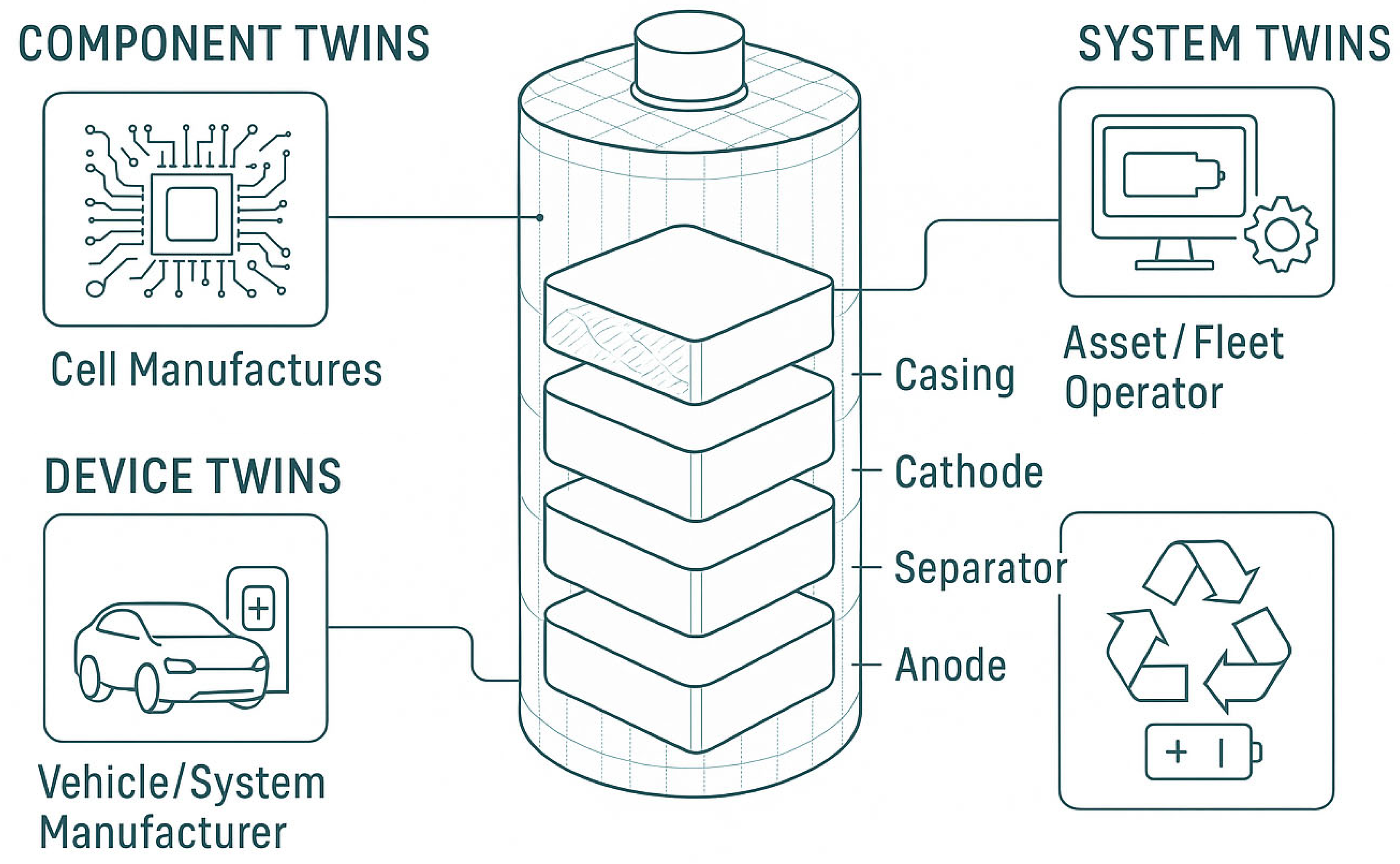
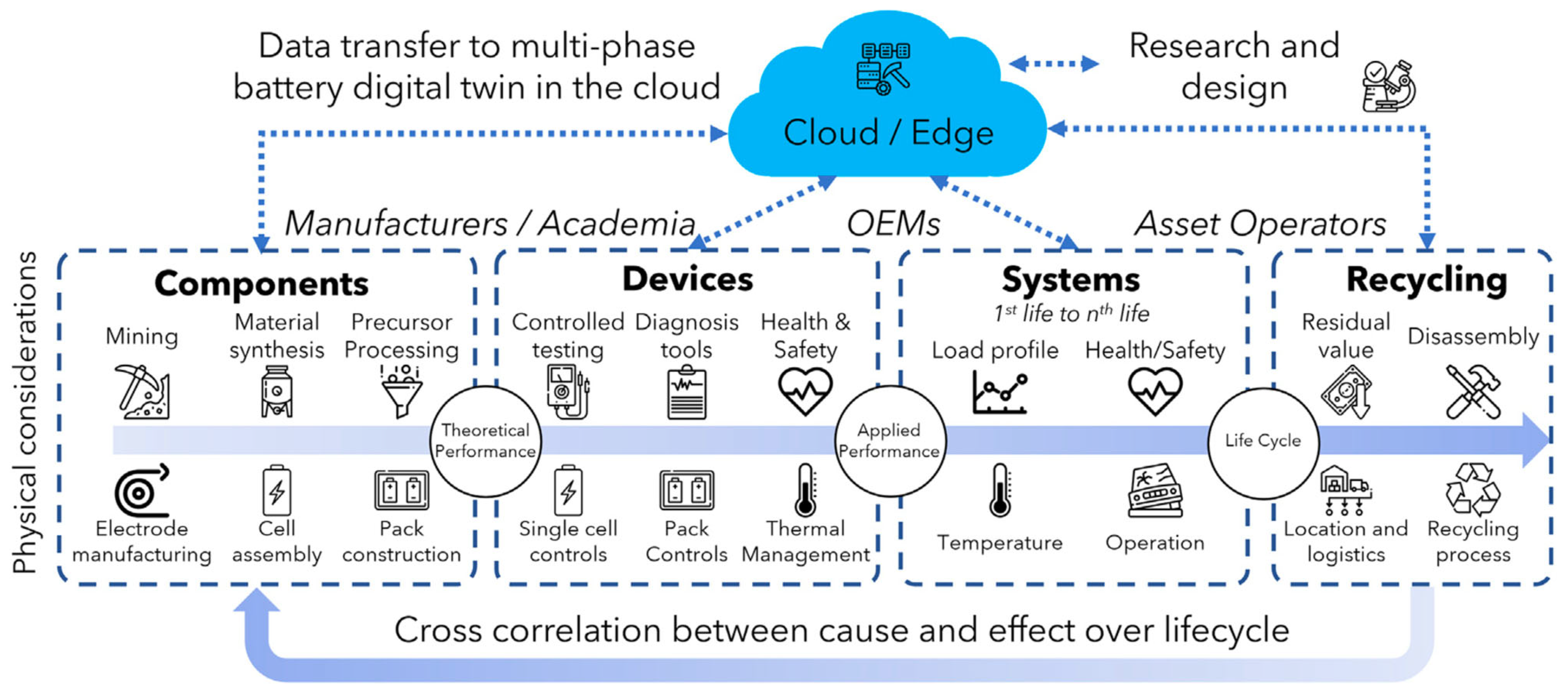
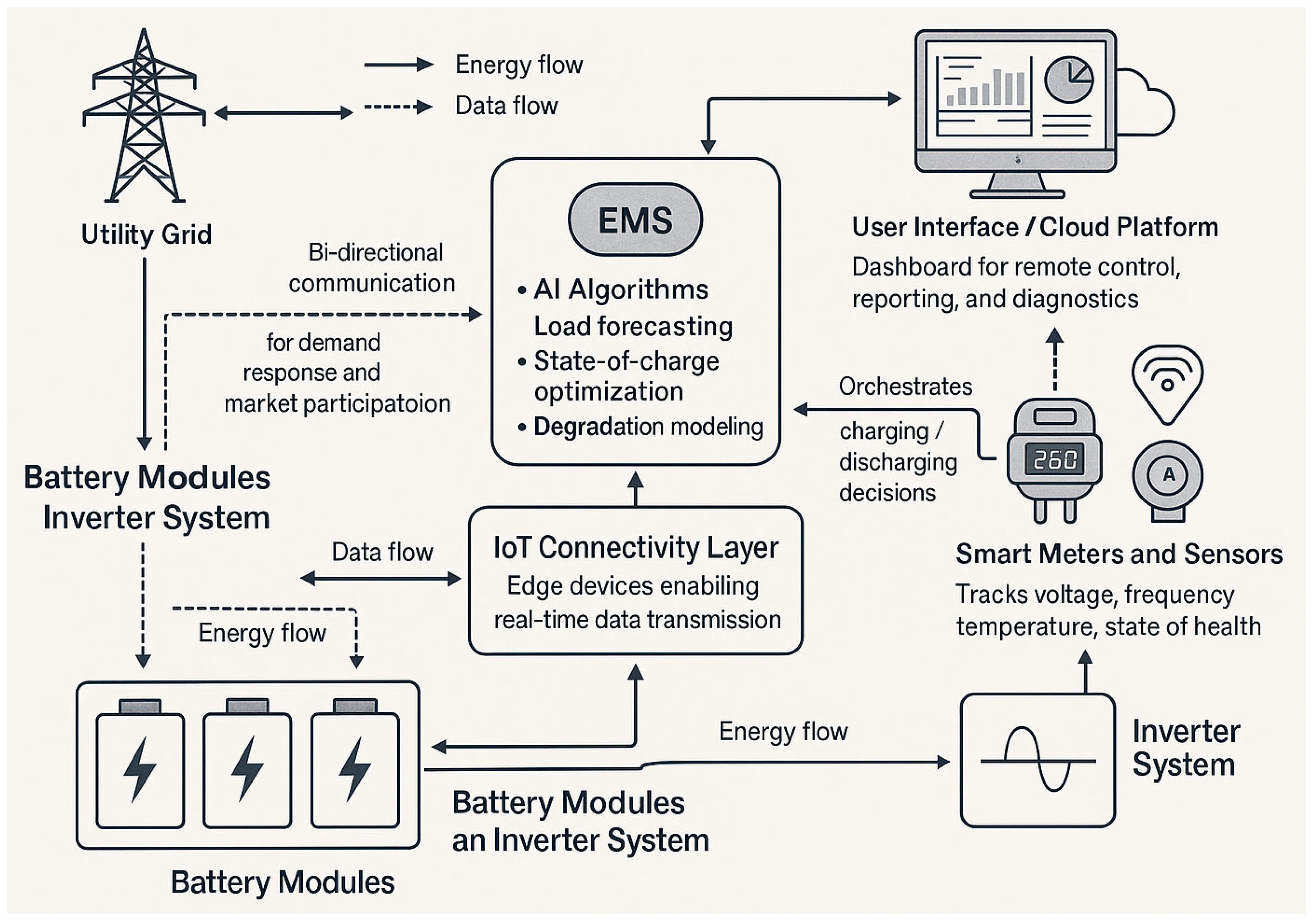
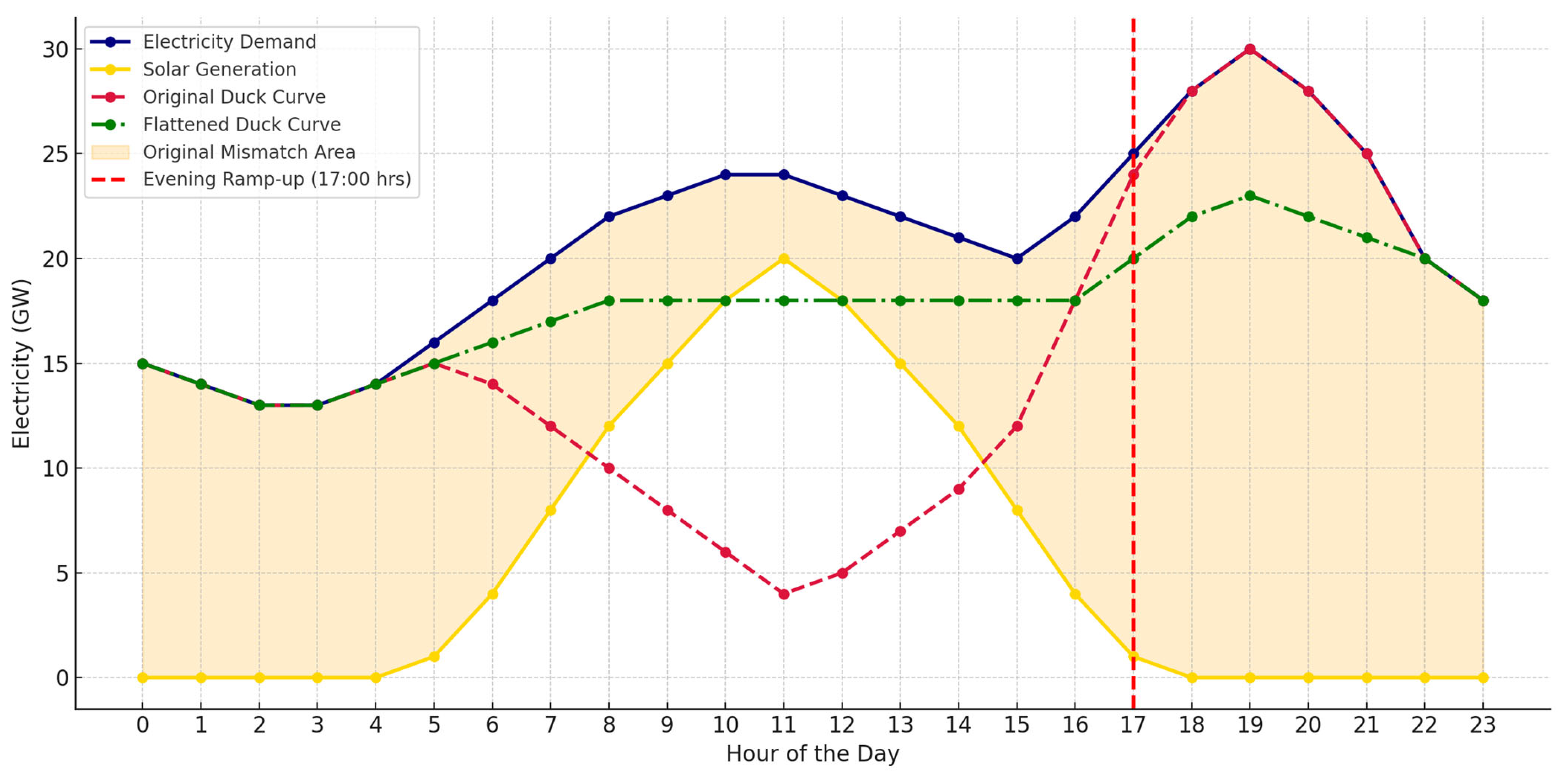
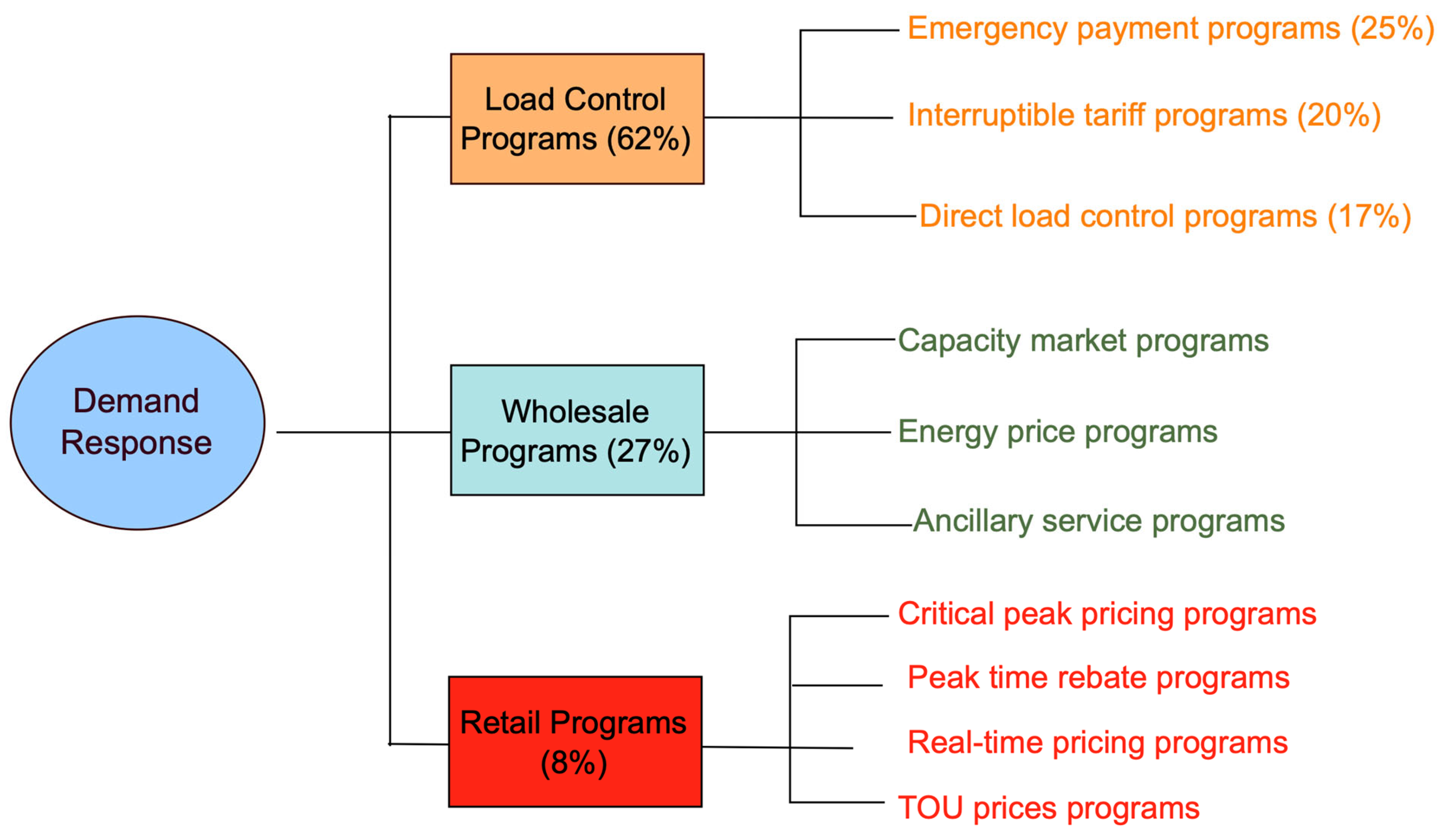
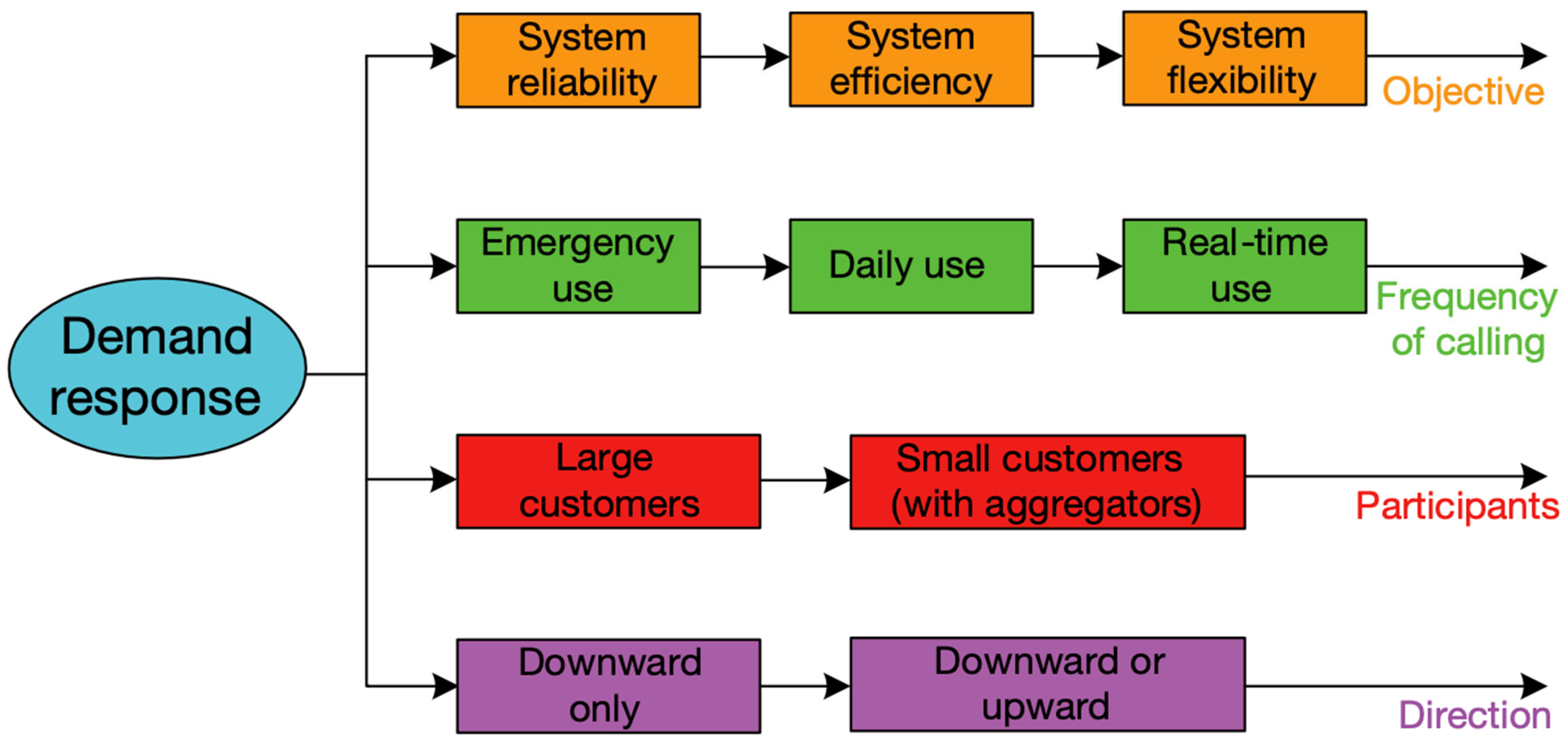
| Advantage Predictive Analytics and Regulatory Strategies | Disadvantages and Risk Mitigation |
|---|---|
| Enhanced forecasting accuracy: Predictive analytics enables more precise load, generation, and price forecasting, reducing uncertainty in grid operations. | Model overfitting or data bias: Over-reliance on historical data may embed systemic bias. Mitigation: Employ robust model validation techniques and include diverse, real-time datasets for training. |
| Proactive grid management: Allows grid operators to anticipate and respond to potential instabilities before they escalate. | False positives and alert fatigue: Excessive automated alerts may lead to desensitization. Mitigation: Design tiered alert systems and human-in-the-loop controls to manage response prioritization. |
| Optimization of DERs and storage assets: AI can dynamically schedule distributed energy resources (DERs) for grid efficiency and economic gains. | Cybersecurity vulnerabilities: Digital control systems increase exposure to cyberattacks. Mitigation: Apply zero-trust architecture, real-time threat detection, and regulatory enforcement of cybersecurity standards. |
| Improved regulatory monitoring: Digitalization enables real-time compliance tracking and market transparency for regulators. | Data privacy concerns: Granular smart meter and user data may raise privacy issues. Mitigation: Implement secure data anonymization protocols and user consent frameworks. |
| Adaptive regulatory frameworks: Regulations can evolve dynamically to accommodate new technologies and market structures. | Regulatory lag: Technology often outpaces policy response. Mitigation: Use regulatory sandboxes and horizon scanning tools to test and co-develop adaptive regulations. |
| System resilience against extreme events: AI-based simulations and digital twins allow scenario-based planning for shocks like weather or supply disruptions. | Limited transparency in AI decisions: Black-box models hinder stakeholder trust. Mitigation: Mandate explainable AI methods and audit trails in high-stakes applications. |
| Stakeholder engagement and market innovation: Open data and digital platforms promote new market entrants and consumer participation (e.g., demand response). | Digital divide and equity gaps: Vulnerable populations may lack access or understanding. Mitigation: Develop inclusive regulatory provisions and targeted digital literacy programs. |
| Specific Integrated Technical Strategy | Key Strengths and Benefits | Major Challenges and Drawbacks | Scalability and Deployment Potential | References/ Supporting Sources |
|---|---|---|---|---|
| Energy storage (BESS + pumped hydro) | Fast response to ramping and peak shifting needs (seconds to minutes) Supports frequency regulation and peak shaving Supports renewable integration. | High capital and operational costs. Limited duration for BESSs; site constraints for pumped hydro Environmental and land-use concerns (esp. hydro) | BESSs: Modular, urban-friendly, rapidly scalable Pumped hydro: High capacity but location-dependent Long-term scalability requires policy and cost reductions | [3,10,51,62] |
| DSM | Cost-effective way to reduce peak loads Enhances grid flexibility without infrastructure overhaul Can leverage consumer behavior and automation | Needs widespread smart meter adoption and consumer education Limited control in critical ramp hours Highly variable effectiveness depending on participation | Scalable through digital platforms and policy mandates Success depends on utility-customer coordination Requires integration into market structures | [4,13,27,28,79,96] |
| Grid flexibility and interconnections | Enables regional energy balancing and load sharing Reduces curtailment of renewables across regions Enhances reliability during generation shortfalls | High capital costs and long permitting timelines Grid congestion and inter-jurisdictional challenges Technical harmonization required between regions | Scalable with regional cooperation and strong governance Suited for large, diverse power systems Long lead times can delay benefits | [1,36,94] |
| Flexible generation (e.g., gas peakers, hybrid plants) | Fast ramping and dispatchable for evening peaks Reliable, dispatchable, mature technology Bridging fuel source; complements intermittent renewables | Fossil fuel-based; increases emissions if not coupled with CCUS Risk of stranded assets in decarbonization pathways Lower efficiency compared to baseload units | Scalable in the short term for transitional stability Long-term use limited by climate policies Hybrid plants (solar/storage/gas) offer greater scalability and transitional flexibility | [1,36,40] |
| Digitization (smart grids, IoT, AI forecasting) | Real-time monitoring and predictive analytics Facilitates automated DSM and DER integration Enhances grid responsiveness to variable conditions | Cybersecurity and data privacy risks High upfront investment in IT and comms infrastructure Requires workforce reskilling and digital literacy | Highly scalable through cloud-based platforms Integration-friendly with legacy and future systems Depends on regulatory support for digital innovation | [17,19,26,95] |
| Specific Integrated Economic Strategy | Key Strengths and Benefits | Major Challenges and Drawbacks | Scalability and Deployment Potential | References/ Supporting Sources |
|---|---|---|---|---|
| Time-of-use (TOU) pricing | Shifts load from peak to off-peak, reducing ramp pressures Provides clear price signals to consumers Low-cost and easy to implement with smart meters | Limited impact without consumer automation May disproportionately affect vulnerable customers Requires consumer education and awareness campaigns | Highly scalable with smart infrastructure Low barrier to entry for utilities Works best in regions with dynamic pricing culture | [97,98] |
| Capacity and ancillary services markets | Monetizes grid flexibility and reliability services Encourages investment in fast-responding resources Helps defer infrastructure upgrades | Complex to design and operate fairly Barriers for small-scale and distributed resources Risk of market manipulation without oversight | Scalable in liberalized electricity markets Requires mature regulatory and metering systems Performance depends on market liquidity and access | [5,9,39] |
| Curtailment strategies | Simple, immediate solution to overgeneration Prevents grid instability during surplus events No new infrastructure needed | Wastes renewable energy; economic and environmental loss Undermines investor confidence in renewables Can become habitual if not paired with better solutions | Not a sustainable long-term strategy Suitable as a last resort or during transition Scalable only with frequent review and compensation mechanisms | [3,9,94] |
| Managed rebound effects (post-DSM or load shifting) | Smooths out demand post-suppression or load deferment Improves DSM effectiveness with rebound prediction tools Prevents secondary peaks from load resumption | Requires advanced modeling and forecasting tools Complexity in consumer behavior modeling Difficult to integrate into basic DSM strategies | Scalable with AI-based demand forecasting Depends on digitization and automated control systems Needs regulatory frameworks for rebound management | [68,88,94] |
| Specific Integrated Policy Strategy | Key Strengths and Benefits | Major Challenges and Drawbacks | Scalability and Deployment Potential | References/ Supporting Sources |
|---|---|---|---|---|
| Renewable Portfolio Standards (RPS) and mandates | Drives large-scale renewable adoption Provides long-term market certainty Encourages innovation and cost reductions | May accelerate duck curve without storage/flexibility mandates Risk of compliance gaps and uneven enforcement Can oversaturate grids without supporting infrastructure | Highly scalable and adopted globally Most effective when paired with flexible resource incentives Requires regular updates to targets and technologies | [2,35,36,94] |
| Net metering and feed-in tariffs (fit) | Promotes distributed generation (especially rooftop PV) Reduces consumer bills and boosts prosumer engagement Simple entry point for renewable energy users | Grid cost recovery challenges for utilities Exacerbates mid-day oversupply (worsens duck curve) May lead to equity issues among ratepayers | Scalable in early-stage markets Needs restructured tariffs over time (net billing, time-variant FiTs) Dependent on regulatory support and utility adaptation | [1,5] |
| Storage incentives and subsidies | Directly accelerates storage adoption (BESSs, V2G, etc.) Reduces peak demand and stabilizes renewables Attracts private sector investment in flexibility | Requires sustained government funding or tax credits Risk of market distortion or dependency Difficult to target optimally without robust analytics | Highly scalable if designed with phase-out mechanisms Drives early-stage markets toward maturity Effective when combined with market-based compensation | [3,9,82] |
| Digitally enabled policy (e.g., smart tariffs, grid codes) | Supports interoperability and standards for digital assets Aligns policy with tech evolution (blockchain, AI, DERs) Facilitates fast and granular grid decisions | Regulatory lag in digital innovation adoption High coordination needed among stakeholders Challenges in policy enforcement and verification | Scalable through modular and open standards Requires harmonization across regions and vendors Needs adaptive regulation frameworks (sandboxing, pilots) | [2,18,48,79] |
| Stakeholder Category | List of Stakeholders | Determinants of Public Acceptance in Energy Transition |
|---|---|---|
| Digital platforms |
|
|
| BESSs |
|
|
| Managed rebound effects |
|
|
Disclaimer/Publisher’s Note: The statements, opinions and data contained in all publications are solely those of the individual author(s) and contributor(s) and not of MDPI and/or the editor(s). MDPI and/or the editor(s) disclaim responsibility for any injury to people or property resulting from any ideas, methods, instructions or products referred to in the content. |
© 2025 by the author. Licensee MDPI, Basel, Switzerland. This article is an open access article distributed under the terms and conditions of the Creative Commons Attribution (CC BY) license (https://creativecommons.org/licenses/by/4.0/).
Share and Cite
Nyangon, J. Smart Grid Strategies for Tackling the Duck Curve: A Qualitative Assessment of Digitalization, Battery Energy Storage, and Managed Rebound Effects Benefits. Energies 2025, 18, 3988. https://doi.org/10.3390/en18153988
Nyangon J. Smart Grid Strategies for Tackling the Duck Curve: A Qualitative Assessment of Digitalization, Battery Energy Storage, and Managed Rebound Effects Benefits. Energies. 2025; 18(15):3988. https://doi.org/10.3390/en18153988
Chicago/Turabian StyleNyangon, Joseph. 2025. "Smart Grid Strategies for Tackling the Duck Curve: A Qualitative Assessment of Digitalization, Battery Energy Storage, and Managed Rebound Effects Benefits" Energies 18, no. 15: 3988. https://doi.org/10.3390/en18153988
APA StyleNyangon, J. (2025). Smart Grid Strategies for Tackling the Duck Curve: A Qualitative Assessment of Digitalization, Battery Energy Storage, and Managed Rebound Effects Benefits. Energies, 18(15), 3988. https://doi.org/10.3390/en18153988






